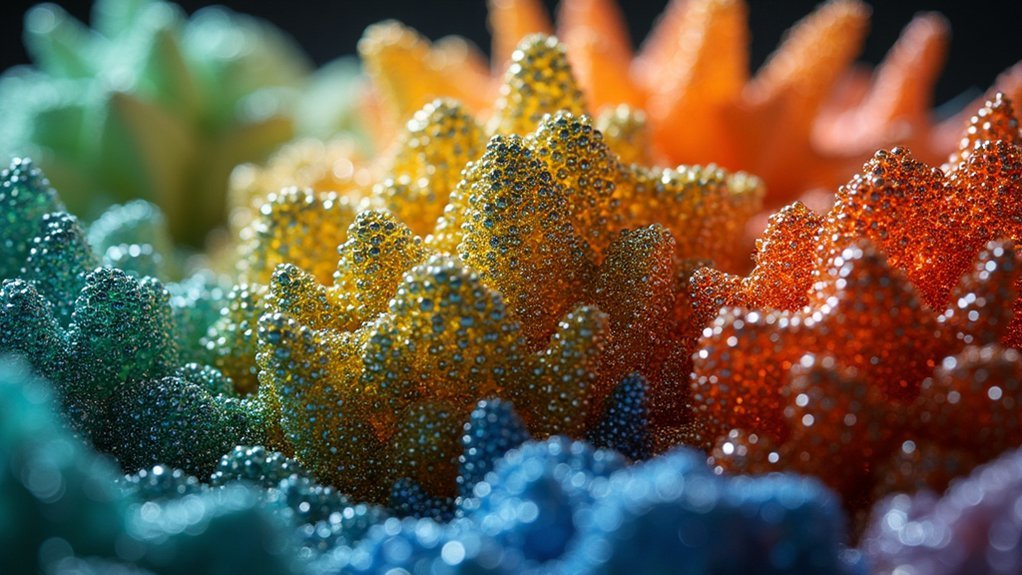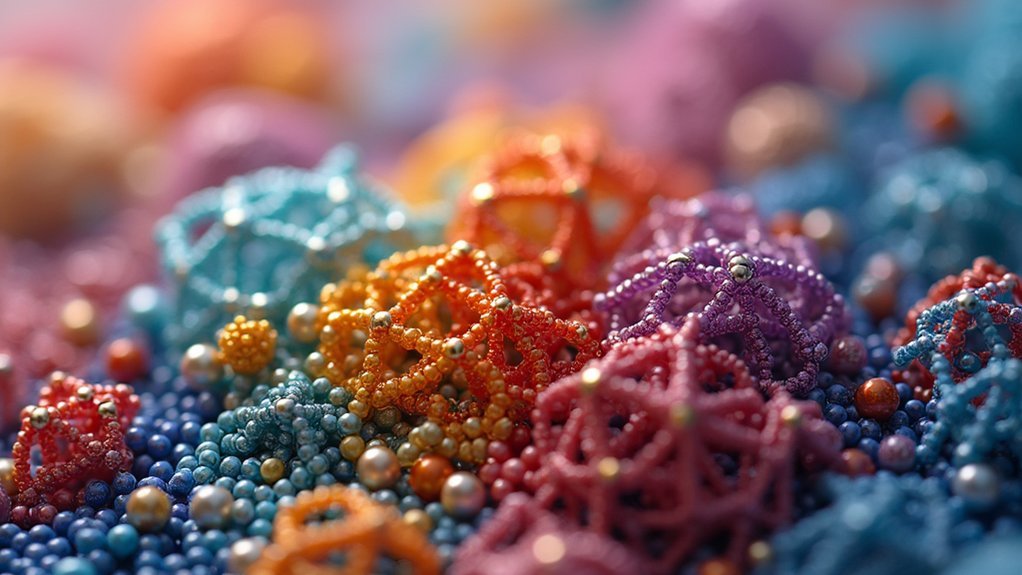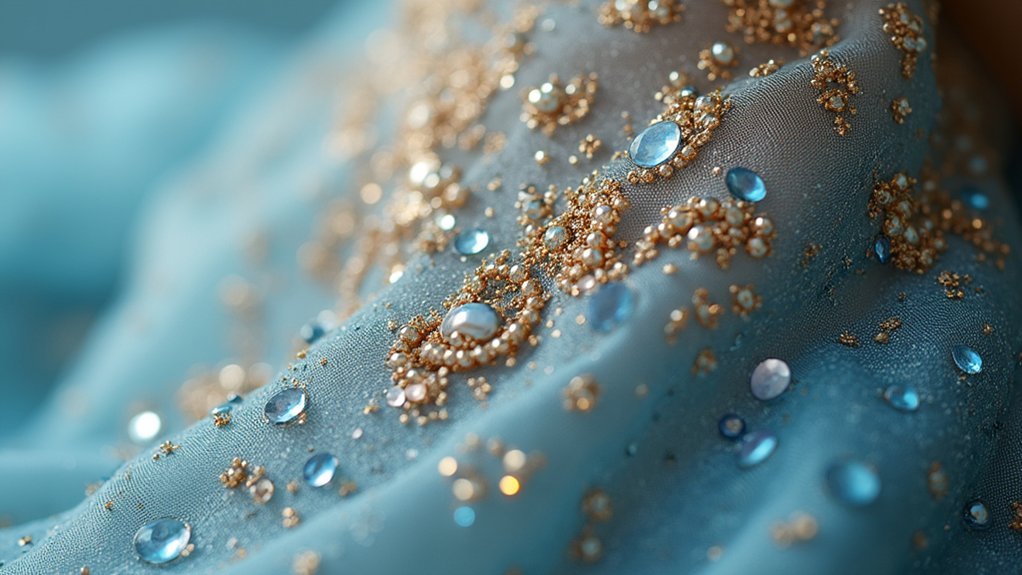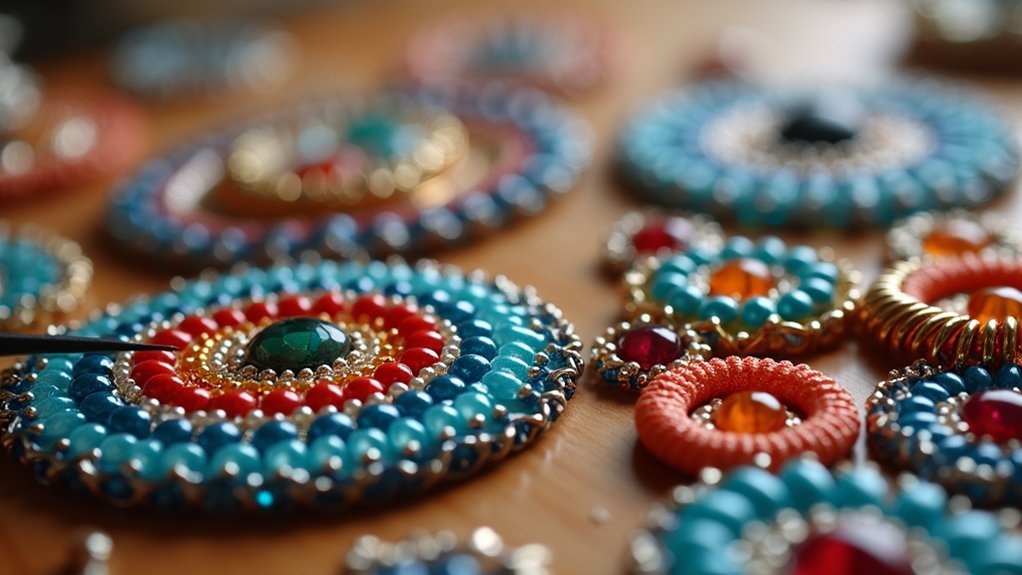You’ll discover five sophisticated beadwork techniques through online courses: peyote stitch variations that transform flat work into three-dimensional sculptures, African helix stitch for creating twisted spiral jewelry structures, tubular polygon construction for intricate geometric shapes, right-angle weave integration with mixed media materials, and couture bead embroidery on silk organza fabric. These methods range from fundamental skills to advanced artistry, incorporating various bead sizes and specialty materials. Master these techniques to access endless creative possibilities in contemporary jewelry design and sculptural art.
Peyote Stitch Variations for Three-Dimensional Sculptural Elements

When you master peyote stitch variations, you’ll release the ability to transform flat beadwork into enchanting three-dimensional sculptures that push beyond traditional jewelry boundaries.
These advanced beading techniques enable you to create intricate flowers, geometric forms, and artistic sculptural pieces through strategic bead placement manipulation.
You’ll discover that mixing different bead sizes and types within your peyote stitch creates stunning textures and visual depth.
The tubular peyote stitch becomes your gateway to crafting hollow forms essential for pendants and decorative elements requiring structural integrity.
Incorporating increases and decreases allows you to form curved and angular shapes, dramatically expanding your artistic possibilities.
When you experiment with strategic stitch placement, you’ll create intricate designs that showcase three-dimensional shapes previously impossible with basic beading methods.
African Helix Stitch Applications in Contemporary Jewelry Design
As you explore advanced beadwork techniques, the African helix stitch transforms your contemporary jewelry design through its distinctive twisted, spiral structure that creates enchanting dimensional effects.
You’ll combine seed beads with larger focal beads, threading them in specific sequences to achieve layered textures that elevate necklaces, bracelets, and earrings beyond traditional flat patterns.
This intricate beadwork technique enables creative color manipulation and form development, producing unique design elements that distinguish your pieces in modern jewelry markets.
Master the African helix stitch to create distinctive, dimensional jewelry pieces that stand out in today’s competitive design marketplace.
When you master this stitch, you’ll greatly expand your creative repertoire, crafting sophisticated patterns and shapes that captivate viewers.
Online courses like Carol Cypher’s provide thorough step-by-step instruction, making this advanced technique accessible whether you’re beginning or experienced in beadwork artistry.
Tubular Polygon Stitch Construction for Geometric Beadwork

Transform your geometric beadwork capabilities through the tubular polygon stitch, a three-dimensional technique that constructs intricate shapes by incorporating three or more sides into your stitch structure.
You’ll master this versatile method through detailed online classes like Carol Cypher’s Craftsy instruction, where you’ll learn precise tension control and proper bead placement essential for advanced techniques.
This contemporary approach expands your creative possibilities in jewelry and art projects.
You’ll discover how various bead types integrate seamlessly with tubular polygon construction, enabling innovative textures and designs.
The technique’s demanding precision develops your fundamental beading skills while opening access to complex beading patterns.
You’ll create stunning three-dimensional forms that transform ordinary beadwork into sophisticated geometric masterpieces, making this stitch invaluable for contemporary jewelry designers seeking distinctive visual impact.
Right-Angle Weave Integration With Mixed Media Materials
Right-angle weave opens exciting pathways for mixed media integration that extend far beyond traditional geometric beadwork boundaries.
You’ll discover this versatile technique creates sturdy dimensional structures perfect for combining with fabric, metal, or leather elements. The method accommodates various bead sizes and shapes, letting you experiment with diverse textures while incorporating embroidery, lace, or found objects into your work.
As you master right-angle weave through online courses, you’ll develop enhanced hand-eye coordination and fine motor skills essential for seamlessly blending beads with mixed media components.
Step-by-step digital instruction allows progressive skill building while adapting techniques to your creative vision. This integration approach enables you to craft unique designs that showcase both traditional beadwork mastery and contemporary artistic expression.
Couture Bead Embroidery Techniques on Silk Organza Fabric

Couture bead embroidery on silk organza demands precision and patience, yet rewards you with breathtakingly elegant results that rival high-fashion runway pieces. You’ll master the art of beading using specialty sequins and precise beading needles to create stunning dimensional effects. Your rotating embroidery frame guarantees accuracy as you stitch intricate patterns.
| Technique Element | Application |
|---|---|
| Specialty Sequins | Create 3D dimensional effects |
| Beading Needles | Precise placement and attachment |
| Rotating Frame | Enhanced accuracy and control |
You’ll receive digital patterns and bead chart templates for reference while progressing at your own pace. The course emphasizes your individual creative journey, letting you use beads to create personalized masterpieces. Online community access provides support and collaboration opportunities, connecting you with fellow artisans exploring couture beading techniques.
Frequently Asked Questions
What Are the Techniques of Beadwork?
You’ll master essential beadwork techniques including peyote stitch for geometric patterns, brick stitch for sturdy motifs, right-angle weave for three-dimensional shapes, bead embroidery on fabric, and freeform beading that encourages your creative expression.
How Long Does It Take to Learn Beading?
You’ll learn basic beading in weeks to months, depending on your practice frequency and commitment. There’s no set timeframe since you’ll progress at your own pace through increasingly complex techniques and designs.
What Do You Call Someone Who Does Beadwork?
You’d call someone who does beadwork a “beader.” If they create artistic designs, you might refer to them as a “bead artist.” Professional beaders often specialize in jewelry design or textile arts.
Is Beadwork Profitable?
You’ll find beadwork quite profitable since handmade pieces sell for 2-5 times material costs. You can earn through direct sales, online platforms, and teaching workshops, especially targeting eco-conscious consumers.
In Summary
You’ll discover these five advanced beadwork techniques transform your jewelry-making skills from basic to professional. You’re now equipped to create dimensional sculptures with peyote variations, incorporate cultural heritage through African helix methods, and construct precise geometric forms using tubular polygon stitches. You can integrate mixed media with right-angle weave and master luxury couture embroidery on delicate fabrics. These online tutorials give you the expertise to elevate your beadwork artistry greatly.





Leave a Reply